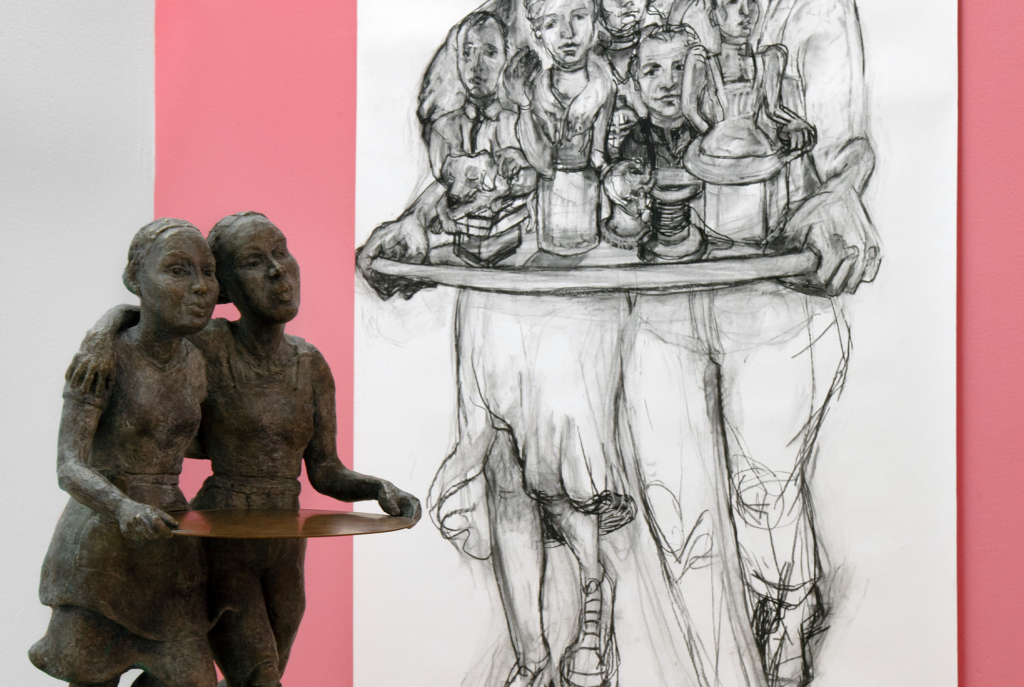We can find all kinds of inspiration in art. Lund’s Skissernas Museum is unique in showcasing the process of art. The museum’s latest temporary exhibition, “Kom som du är”, especially invites both artist and visitor to come as they are.
The Skissernas Museum could not be more centrally located in Lund, yet its large brown and ochre-coloured facade is easily passed by, blending in with the now quickly orange-turning trees in front of the Universitetsbiblioteket. Walking by, you might catch sight of the museum shop and the somewhat confusing concrete structure of the building, or stumble past the few statues outside in the park. What hides here?
“Kom som du är” follows the museum’s theme of models for artwork meant to be displaced in the public space. The exhibition, for instance, includes a study for a mural meant to transform a Stockholm metro station into a deep sea cave and shows how tiny matchboxes can be stacked together to form a large arch. In another room, a little boy made of twigs sits and contemplates.
Besides these smaller marvels, the exhibition’s dominating piece and name-giver welcomes you in and sees you out as you find your way around the exhibition rooms. The 1:3-scale model and a life-sized charcoal sketch of Astrid Göransson’s sculpture “Kom som du är” depict two young girls holding up a tray, while a megaphone sticks out of one of their back pockets. Their clay eyes gaze forward and upward.
Following the sketches and signs displayed on the bright pink museum walls, the story of the artwork becomes clear. Made for the 100th anniversary of women’s suffrage in Sweden and placed near the Riksdag in Stockholm, Göransson’s girls carry the portraits of the first five women elected to the Swedish parliament.
In doing so, the artist connects the stories of Kerstin Hesselgren, Elisabeth Tamm, Nelly Thüring, Bertha Wellin and Agda Östlund to the two clay girls in front of us in Lund as well as to their bronze counterparts in Stockholm. Although the work does not speak, it comments on much more than ‘just’ the anniversary of a political process we have all become so accustomed to over the past century.
Sweden receives a shining full score on political rights and civil liberties from the Freedom House, an internationally recognised agency tracking democracy all over the world. Since the 1980s, Sweden has also not had a voter turnout below eighty per cent. Still, with her work, Göransson aims to show how the “fight for democracy and gender equality continues into the future”.
We can celebrate the structure of democracy by recognising the room it gives for discussion.
We can celebrate the structure of democracy by recognising the room it gives for discussion. The system works, yet there are also many political and public debates around issues of racism, violence, and xenophobia. Faced with the challenges of today, we should assess what voices dominate, and what perspectives are missing.
In Europe generally, conservative and populist views are more and more common and question how the true “will of the people” should be represented. Populism may frame politics as if there are only two groups, countering the people against some corrupt other, without defining who “the people” are and who this group represents.
Democratic rights are a privilege to be celebrated, but also a responsibility that should be taken seriously. This requires open democratic spaces where different perspectives can meet and people can learn from others’ experiences.
While Göransson’s main sculpture most explicitly invites us to reflect on gender, her accompanying book, “Rundan” (Rounds, in Swedish), portrays a similar view on representation and recognition. As a preparatory study for the monument, Göransson interviewed Riskdag security and cleaning staff about their daily rounds. In exchange, she drew the workers portraits. In this way, “Rundan” pays tribute to democracy’s rarely publicly recognised support network.
Just like the “practical caretakers” of democracy, our collective support maintains political systems in seen and unseen ways. Although voting is the most obvious, engaging with news and discussing our perspectives with friends, family, and colleagues supports a continuous and collective debate about how we want our environment and societies to function.
Ultimately, Göransson inspires us to take democracy’s 100th birthday as a reason to reflect on the power of our democratic voice. Whom do we allow to speak through the statue’s megaphone? From government workers to politicians and students, we all have different identities, experiences, and perspectives. Göransson’s statue carries on its platter five voices from the past. What voice and perspectives do we want to present from our time?
Skissernas’ “Kom som du är” is open until February 18th. Admission for students is free – no excuse to visit just as you are!









